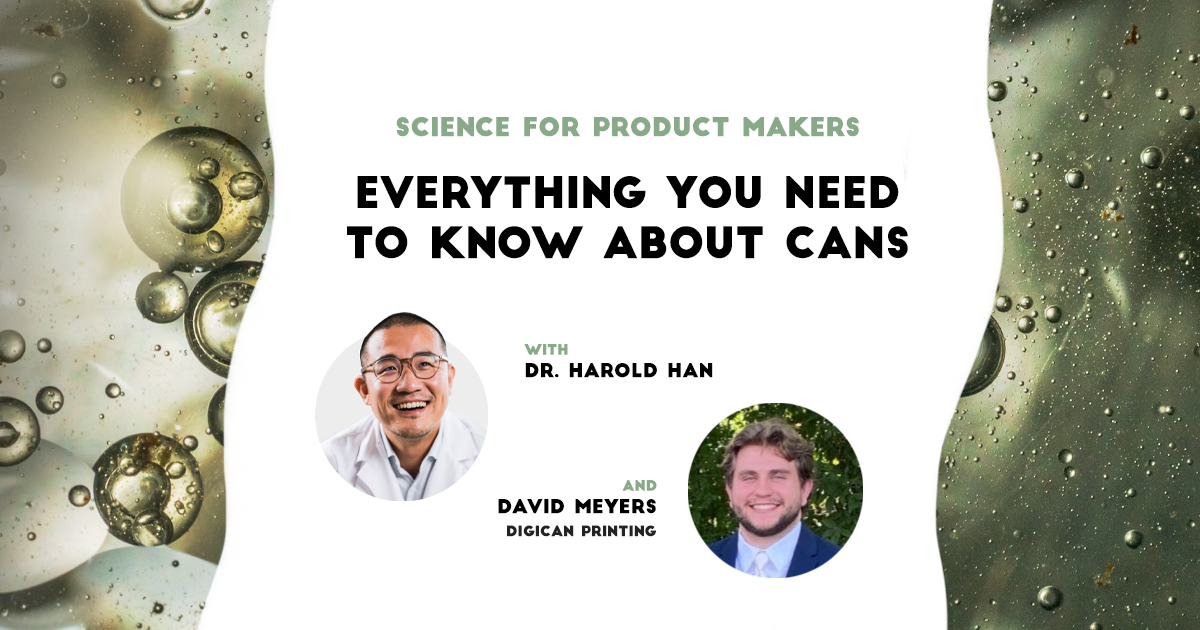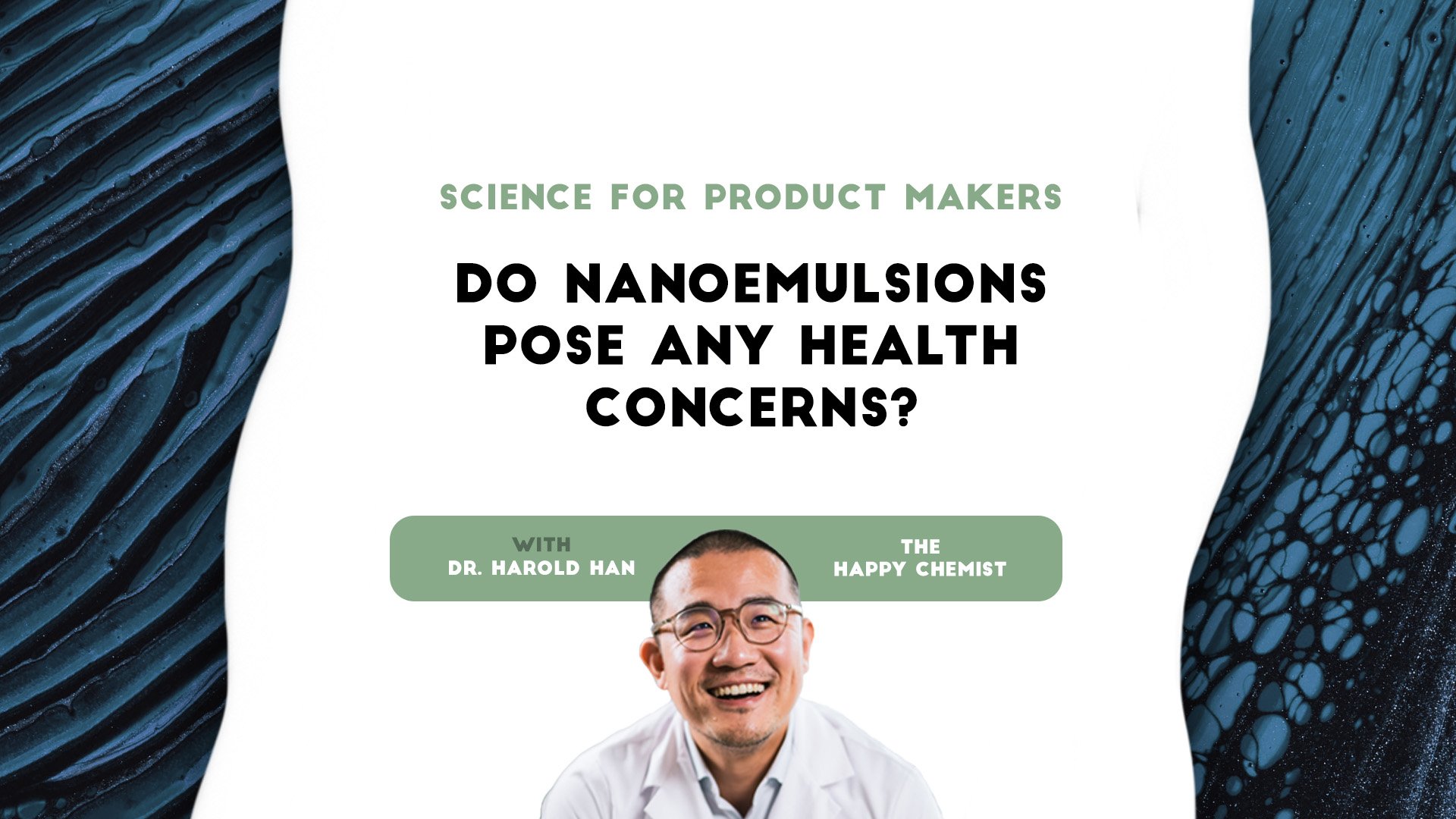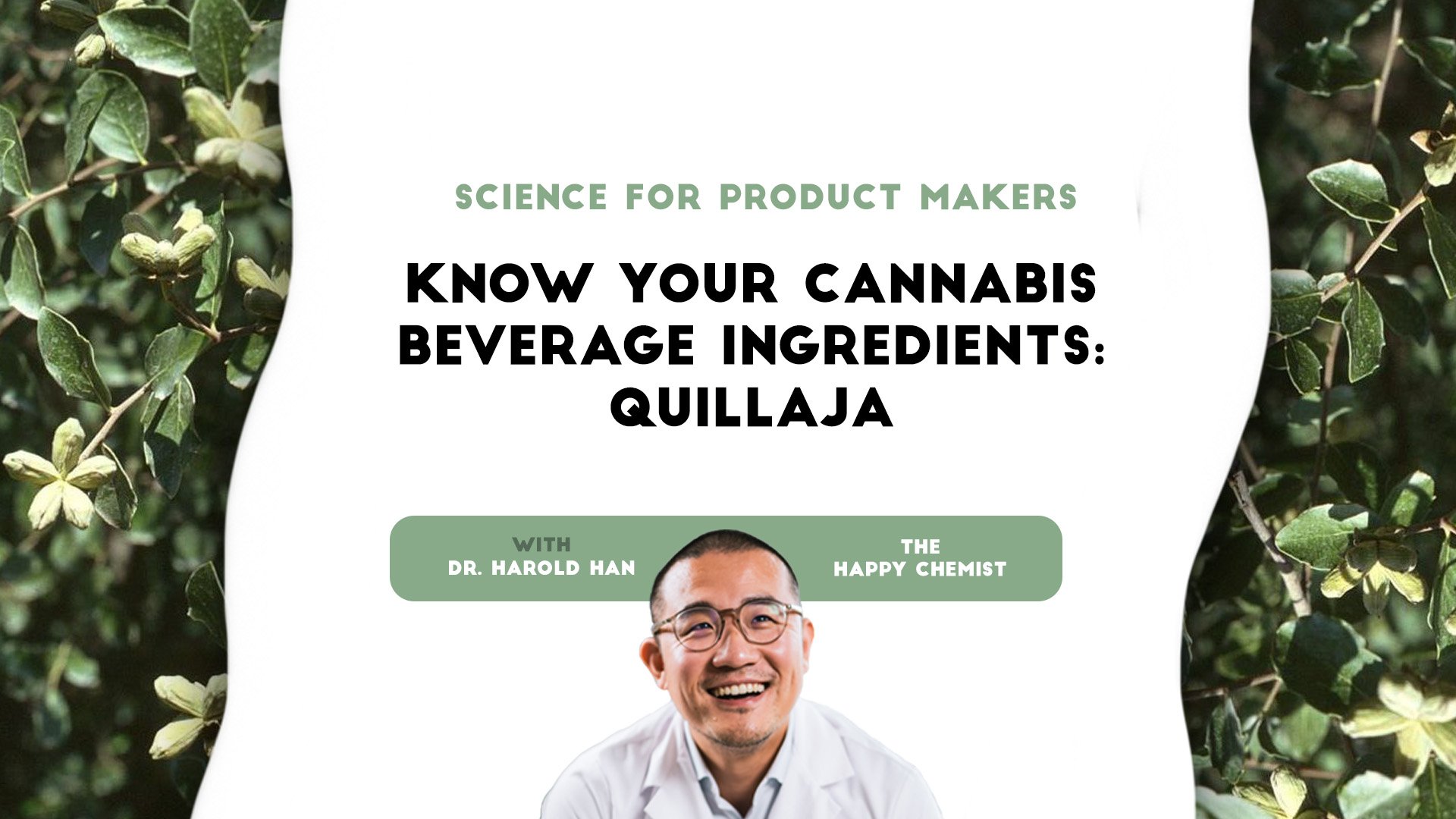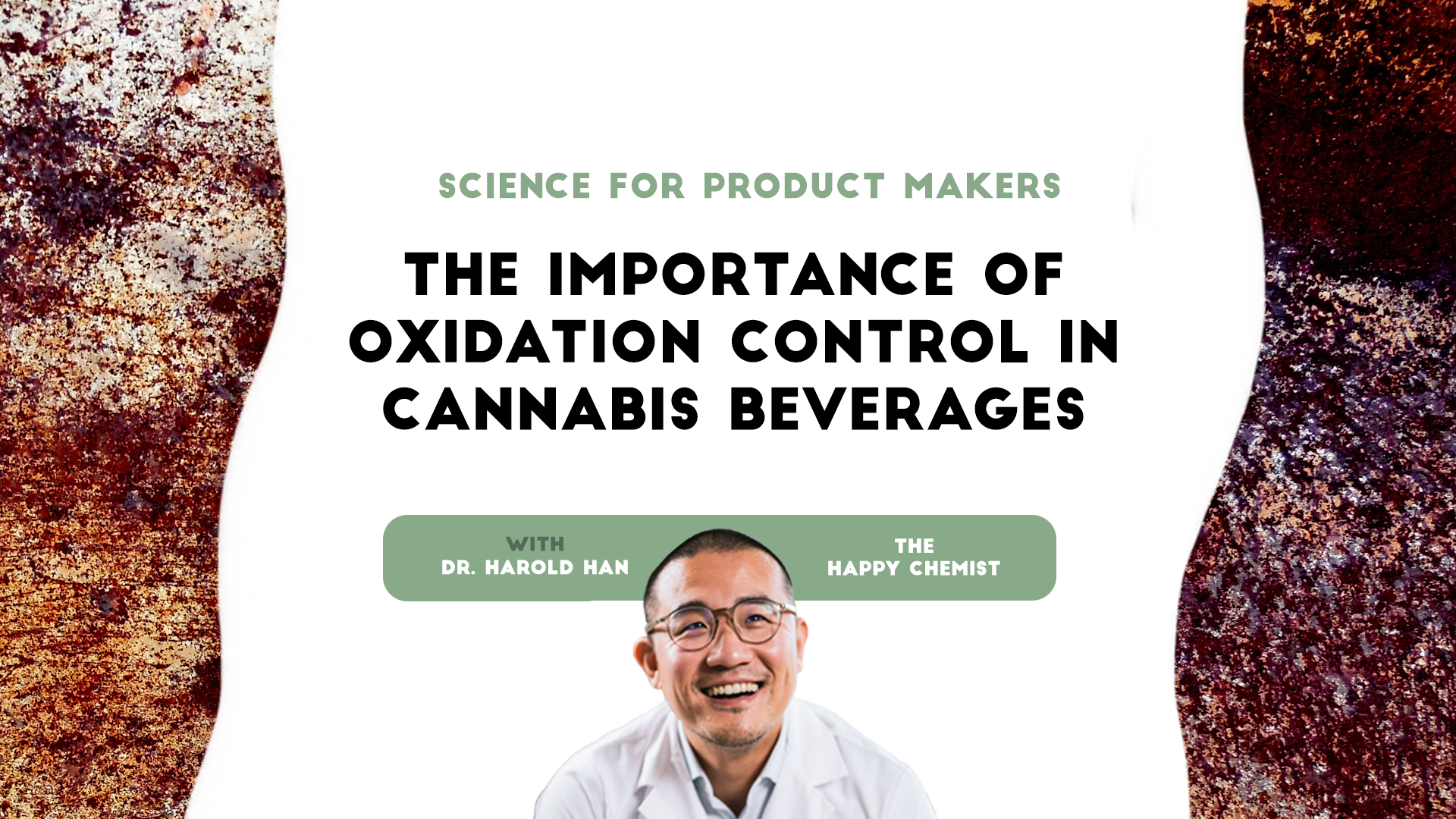Science for product makers: do nanoemulsions pose any health concerns?
This post is also published as an article on Harold's LinkedIn profile. You can read and leave comments here.
5 min read
 Dr. Harold Han - "The Happy Chemist"
:
9/3/24 4:50 PM
Dr. Harold Han - "The Happy Chemist"
:
9/3/24 4:50 PM

This post was originally published on August 9, 2024, as an article on Harold's LinkedIn profile. You can read and leave comments here.
This issue of Science for Product Makers was written in partnership with David J. Meyers, Process Development Engineer at DigiCan Printing.
Beverage brands that use aluminum cans are no strangers to scalping. Scalping refers to the loss of potency when certain active compounds in the drink stick to the inside of the can. Hydrophobic actives are more likely to stick to the can, leading to a higher scalping rate. This is particularly common with cannabinoids.
Because of this issue, six years ago, most cannabis beverage brands in California had to use glass bottles. Since then, the industry has learned a lot. We can now confidently make THC drinks that stay stable for 12 months in cans.
Despite this progress, many cannabis beverage brands still struggle to navigate the complexities of the aluminum can supply chain and the process of choosing the right ones. As cannabis infusion experts, we also struggled with this selection process in the beginning, but have learned a lot from our last 6 years of business. Today, I’d like to share some of these key insights.
Aluminum cans are lined to prevent the can’s contents from reacting with the aluminum. Without it, the can’s integrity and the beverage’s flavor can be compromised. Liner manufacturers produce liner resin as a chemical material, while can manufacturers produce the aluminum can and spray this liner resin on the inside.
Technologically speaking, can manufacturers could potentially spray any liner on their cans, but traditionally, large can manufacturers have long term contracts with certain liner providers. Ball, for example, mostly uses Valsper liners, so many used the can manufacturers' name as shorthand to imply liner type. Recently, however, can manufacturers have been more flexible with their liner options in anticipation of supply chain issues. This means only using the can manufacturers’ name to imply liner type has become unreliable.
Main liner manufacturers: Sherwin-Williams (owner of Valsper), Akzonnobel, PPG
Main aluminum can manufacturers: Ball, Ardagh, CanPak, Crown, MCC (Metal Container Company), Envasas, Vobev and American Canning.
BPA, or Bisphenol A, is also called Epoxy liner. This chemical has been used for decades to harden the epoxy resin in can liners. Exposure to BPA can lead to multiple health issues but people argue the amount present in can liners is not high enough to cause those adverse effects. California Prop 65 requires brands to clearly label BPA and its potential health issues.
BPANI, or BPA Non-Intent, is a different liner chemistry that does not need BPA. This liner type is now widely used in the industry.
It is not enough to describe a can liner as BPA or BPANI. This only tells part of the liner’s chemical story. There are many types of BPANI liners made by many different liner manufacturers. The best way to identify a can liner is by its code name, which is directly connected to its chemical composition.
Below are some liner codes that have good stability for cannabis beverages:
Minimum order quantities for aluminum cans can be too high for a single cannabis beverage brand to reach this volume currently. Most brands work with can distributors who buy in bulk from can manufacturers and resell in smaller quantities. Sometimes, beverage co-manufacturers are also able to acquire cans for their clients.
The can you are about to use may have gone through multiple transactions and it is very easy to lose track of its original information. For smaller cannabis beverage clients, it can sometimes be hard to get more than an oral confirmation about your cans’ liner type. We have seen cases where this uncertainty causes downstream potency stability issues. Below are some key pieces of information you need to know before using the can.
This is the most important information to obtain and it can be found in the liner specification sheet. Here is a list of stable can liner types for cannabis beverages: Epoxy, Valspar V70 Q38, Valspar V70 Q11, aTULC. Ask for this sheet from your can seller!
The can code reveals lots of good information about when and where this can was produced. For unprinted brite cans, there is usually a can code located on the bottom of the can. Sometimes this code is only visible under a black-light.

Keep in mind that each can manufacturer has their own code system. Below is an example of can codes from Ball. If you need help interpreting other can codes, reach out to the Vertosa team for help!

When a can is over 2 years old, the liner is generally believed to be deteriorated due to oxidation. Especially if it was stored in an environment with high temperature or humidity. Use the can code to help determine and/or confirm a can’s age.
How the liner material is sprayed onto the can is very important. The inside of high quality cans usually have an evenly applied liner. Differences in local environmental standards impact how well a manufacturer can spray liners into the can. We have seen some cans manufactured overseas with variable quality, leading to downstream issues. Uneven spray leads to higher scalping rates and may also lead to erosion of and bursting cans.
Spray weights are used to describe the thickness of the liner. The liquid’s tendency to corrode is the main consideration when selecting liner thickness. For example, energy drinks have a low pH, leading them to use the thickest liners available. Most brite cans use this weight because the final contents of the can are unknown.
Don’t automatically assume all the sizes of your can have the same liner. It is often the case that your can distributor sells 8 oz cans and 12 oz cans with totally different liners. Be sure to confirm the liner information before making a decision.
High DO levels erode cans and can sometimes even leach them, so many industries set DO = 1.2 ppm (1200 ppb) as a threshold (Source). This is especially important for cannabis infused beverage makers because oxygen causes cannabinoid potency loss from oxidation. Confirm with your beverage co-manufacturer on this issue!
Large can manufacturers will usually print a brand’s label design onto the can using offset printing. Cannabis beverage brands, however, are rarely able to meet the volume requirements for it. And since regulations change often, frequent label updates make utilizing offset printing even more impractical.
Many brands buy brite cans and apply pressure sensitive labels (PSL), or shrink wrapped labels, which can produce decent quality artwork. Recently, a newer technology called Digital Printing emerged, which can digitally print any design directly on the outside of a brite can. This method is advantageous in cannabis beverage industry thanks to short turnaround times, allowing brands to be more agile in a constantly shifting market landscape.
Digital can providers’ main focus is mainly on aesthetics and ink stability on the outside of the can. It is important for brands to pay attention to the inner liner type to avoid scalping.
Most cannabis beverage brands do not have the negotiating power to work directly with can manufacturers. We usually get what we can at the price / volume we can afford. But we could be smarter about what to look for. The aluminum can supply chain can be quite complex and most times brands don’t even get authentic spec sheets. It’s important to keep asking for those spec sheets and to use the information above to confirm you get the correct can. I hope that this guide was helpful!
* aTULC follows a different production path where the special liner is coated on both sides of the aluminum sheet, which is then made into the finished can.
Dr. Harold Han — the “Happy Chemist” — combines his storied background in emulsion chemistry and science with curiosity and fascination in the rapidly growing cannabis industry. Developing nano and micro emulsions his entire career, Harold holds a Ph.D in Surface Chemistry from NYU and is the holder of multiple patents for his inventions in emulsion chemistry.
As the Chief Science Officer at Vertosa, Harold spearheads the company’s development of industry-leading and customized active ingredients for infused product makers, offering pre-suspended aqueous solutions to create incredibly homogenous and stable products while maximizing bioavailability, clarity, and taste.
To learn more about the science of cannabis, make sure to follow Harold on LinkedIn and check out his Happy Chemist videos.

This post is also published as an article on Harold's LinkedIn profile. You can read and leave comments here.

This post is also published as an article on Harold's LinkedIn profile. You can read and leave comments here.

Potency stability remains one of the most important objectives of making cannabis infused beverages. Unlike most cannabinoids, liquor can be stored...